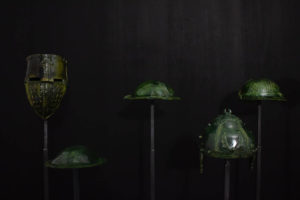A solo exhibition by Vera Tamara
Reviewed by Penny Johnson
Organized by Gallery One at Khalil Sakakini Cultural Centre
Open from 10:00 to 20:00 daily, except Thursdays and Fridays, until January 12, 2020
On a table in our home, a figure of a woman sits in the outer courtyard of her house, a pan in her lap, pots of cactus beside her, and tall pines behind her. The windows and doors of the house are inviting – but the house is split in two. Vera Tamari’s 1980s ceramic piece speaks both of quiet domesticity and public violence, the latter presented as a jagged crack separating the woman from the entrance to her home. In Vera’s other works of that tumultuous time, we experience violence even more directly as in the mourning figures of Mothers of the Martyrs, although the perpetrator – the Israeli occupation and its forces – is still absent.
All these qualities – the intersecting themes of public violence and intimate lives, the evocation of loss and a celebration of beauty – are explored and amplified in this signal exhibition of Vera’s new work, Warriors Passed by Here. The scale of the artist’s attention has shifted from home – so ably and intimately portrayed in earlier bas-relief ceramic works based on pre-Nakba family photographs – to land and seascapes in watercolor, acrylic, and mixed media, in addition to sensuous sculptural pieces. The public violence expressed as a crack in a home in the earlier work, evoking the house demolitions of the time, is now powerfully represented in this exhibition by a series of ceramic helmets of invaders of the land – from the Bronze Age to the present. The artist who responded to the systematic Israeli army and settlers’ uprooting of olive trees in Palestinian orchards by creating over 600 trees in clay, painted in pastel colors in her 2002 work Tale of a Tree, now looks farther back. Thinking as well of the lovely watercolors in this exhibit, Vera remarked: “My landscapes were too idyllic. I began to think of all the armies that have marched through the land and its orchards.”

In a room in the main building, the visitor will encounter colorful landscapes dotted with olive trees, painted in watercolor on delicate Japanese paper and suspended on the walls, juxtaposed in the same room with an installation of a group of helmets in clay. Warriors, indeed, passed by here – as the Israeli army continues to do in the nighttime streets of Ramallah. The march of helmets reminds us of a striking installation titled Going for a Ride? that Vera created in response to the 2002 Israeli incursion into Ramallah and other Palestinian cities when army tanks rolled over and crushed Palestinian cars whose unlucky owners had parked them on city streets.

Variable sizes, approximate diameter 30 cm each, 2019.
Just as these helmets – whether Persian, Roman, Crusader, Israeli, or imagined – evocatively stand for the human armies that have crisscrossed the land, and continue to do so, the human figure in the exhibit, so evident in the earlier ceramic pieces, has also either vanished or is abstract and sculptural, the latter quality recalling Vera’s training and skill as a potter. Women have metamorphosed into swirling olive trees on fabric – or, in another interpretation, olive tree trunks have changed into sensuous female bodies – in her series entitled Dance, displayed in the street-level garage gallery. Vera’s turn towards abstract form is also prominent in the next room where the hills of Palestine’s central highlands are portrayed in small watercolor collages and larger bright acrylic abstract forms – that, indeed, also seem to dance across the canvas.

In Warriors Passed by Here, Vera draws on her intimate memories, her visions, both troubled and beautiful, of Palestinian land and seascapes, and her interrogation of the past of a fragile and battle-scarred land, work she created in tandem with her role as a teacher at Birzeit University and a founder of the university’s museum. The new work in this exhibit evokes the many stages of her artistic development over half a century. Like many artists with decades of creative work behind them, Vera’s new work is both a departure and a homecoming. And for viewers who have followed her work over decades and for those who come new to it through this exhibit, the work offers both pleasures and challenges.

